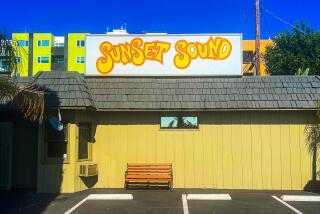Review: LCD Soundsystem’s ‘American Dream’ isn’t a victory lap — it’s better than that
Well, of course he got the band back together. Going out on top — and then just staying that way? It would’ve seemed counter to the animating spirit of the thing.
When James Murphy started LCD Soundsystem in 2002, the singer, producer and vintage-synth connoisseur introduced the group with “Losing My Edge,” an instant-classic disco-punk single in which Murphy, then in his early 30s, vividly described his fear of being made to look out of touch by a younger, savvier generation of music snobs.
With a killer bass line and pitch-perfect references to “Internet seekers” and “art-school Brooklynites in little jackets,” the song was a spasm of worry you could dance to — and it made an unlikely star of the lumpy record nerd whose late-breaking celebrity he treated like a joke.
But a funny thing happened on the way to Murphy’s obsolescence: He maintained his edge. In fact, he may have sharpened it, releasing three albums that only solidified LCD Soundsystem’s reputation as perhaps the coolest band in New York.
In 2011, still convinced he was on the cusp of irrelevance, Murphy killed off the group following an epic goodbye concert at Madison Square Garden. The legend, it seemed, was safe.
Until now.
Last year Murphy revived LCD Soundsystem — whose core members include keyboardist Nancy Whang, drummer Pat Mahoney and guitarist Al Doyle — to headline Coachella and play a handful of other lucrative festival gigs. The reunion, a mere five years after the band’s ballyhooed breakup, struck many observers as a cash-grab; some fans complained it cheapened their emotional investment in the farewell show (a charge Murphy took up with clear feeling in a classy Facebook post).
But to listen to him on “American Dream,” the impressive new LCD Soundsystem album due Friday, is to believe that prestige was no kind of afterlife for Murphy. In these yearning, jittery tunes — some consistent with his long-held anxieties, others about the fresh troubles of an older man — the singer, now 47, sounds almost grateful to be back in a familiar state of unease.
He didn’t reform the band for a victory lap, in other words; he did it because he missed the feeling of running to keep up.

“‘What’s it you do again?’” somebody probably half his age asks him in “Tonite,” and the answer comes caked in his sneering self-deprecation: “‘Oh, I’m a reminder: a hobbled veteran of the disk-shop inquisition / Sent to parry the cocksure mem-stick filth with mine own late-era middle-aged ramblings.” (These are no doubt the lyrics that inspired Father John Misty to offer up an earnest Facebook post of his own recently in which he described “Tonite” as “miraculous.”)
In the funky, jagged “Change Yr Mind” he’s back in his “Losing My Edge” mindset, admitting, “I’m not dangerous now, the way I used to be once.”
But Murphy is also facing bigger, more existential worries than he likely could’ve imagined a decade and a half ago. The album’s moving closer, “Black Screen,” appears to be about the time he spent working with his hero David Bowie on Bowie’s album “Blackstar,” which was released just days before the rock legend died last year.
“I had fear in the room, so I stopped turning up,” he sings over a gentle but ominous groove, “My hands kept pushing down in my pockets / I’m bad with people things, but I should have tried more.”
Elsewhere he describes being abandoned by a lifelong friend (“Standing on the shore getting old / You left me here with the vape clowns”) and invokes the slow degradation of his body: flaking skin, a calming heartbeat, wrinkles revealed by the morning sun.
Maybe Murphy could’ve put all this stuff in a book; maybe he could’ve annotated the menu at the wine bar he opened with his wife during LCD Soundsystem’s hiatus. But music is the natural repository for Murphy’s thoughts, so songs are where he put them.
And, man, can this guy build a song. As detail-obsessed a producer as any working today — consult “American Dream’s” liner notes for the make and model of every keyboard he used — Murphy skillfully layers his sounds for tracks that somehow feel dense and airy at the same time.
This record lacks the kind of go-go rave-up that each previous LCD Soundsystem album had; there’s no “Drunk Girls” or “Daft Punk Is Playing at My House” here. And with its rumbling drums and spacey atmospherics, “How Do You Sleep?” comes closer to “The Dark Side of the Moon” than most former punks would dare.
But even when he’s blissing out (or trying desperately to), Murphy’s trademark nerves define the gorgeously queasy vibe of “American Dream.” Success, thank goodness, simply doesn’t look good on him.
Twitter: @mikaelwood
ALSO
Is Taylor Swift trying to turn off her listeners?
‘It’s part of our DNA’: How California shaped the music of L.A.’s Haim
What Donald Trump had to do with the smash-hit remix of ‘Despacito’
More to Read
The biggest entertainment stories
Get our big stories about Hollywood, film, television, music, arts, culture and more right in your inbox as soon as they publish.
You may occasionally receive promotional content from the Los Angeles Times.







